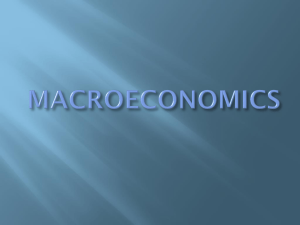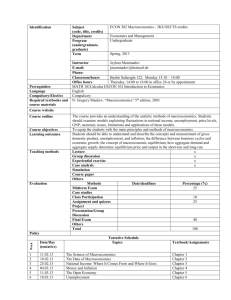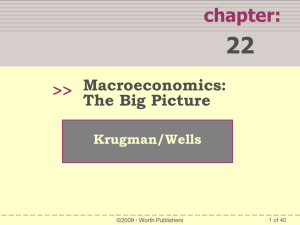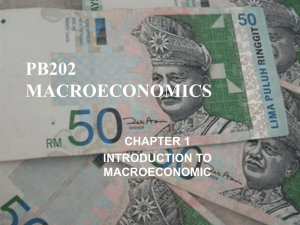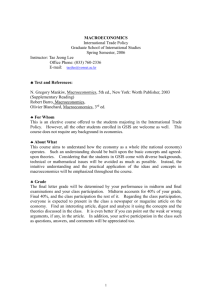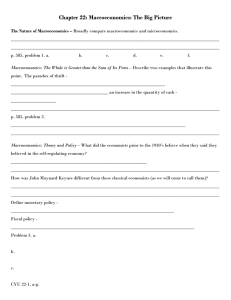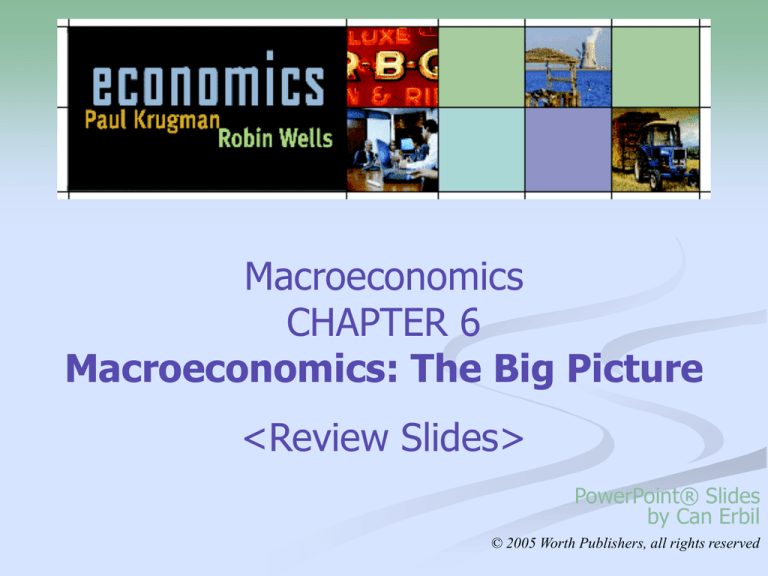
Macroeconomics
CHAPTER 6
Macroeconomics: The Big Picture
<Review Slides>
PowerPoint® Slides
by Can Erbil
© 2005 Worth Publishers, all rights reserved
What you will learn in this chapter:
An overview of macroeconomics, the study of the economy as
a whole, and how it differs from microeconomics
The importance of the business cycle and why policymakers seek to diminish the severity of business cycles
What long-run growth is and how it determines a country’s
standard of living
The meaning of inflation and deflation and why price
stability is preferred
What is special about the macroeconomics of an open
economy, an economy that trades goods, services and
assets with other countries
2
Macroeconomics vs. Microeconomics
Microeconomics focuses on how decisions are made by
individuals and firms and the consequences of those decisions.
Ex.:
How much it would cost for a university or college to
offer a new course? (including the cost of the instructor’s
salary, the classroom facilities, the class materials, and so on).
Having determined the cost, the school can then decide
whether to offer the course.
3
Macroeconomics vs. Microeconomics
Macroeconomics examines the aggregate behavior of the
economy ─ how the actions of all the individuals and firms in the
economy interact to produce a particular level of economic
performance as a whole.
Ex.:
Overall level of prices in the economy (how high or how
low they are relative to prices last year) rather than the price
of a particular good or service.
4
The Great Depression
The Great Depression precipitated a thorough rethinking of
macroeconomics, which gave rise to modern macroeconomics.
5
The Business Cycle
The business cycle is the short-run alternation between
economic downturns and economic upturns.
A depression is a very deep and prolonged downturn.
Recessions are periods of economic downturns when output
and employment are falling.
Expansions, sometimes called recoveries, are periods of
economic upturns when output and employment are rising.
6
History of the unemployment rate
since 1948
7
The Business Cycle
What happens during a business cycle, and what can be done
about it?
the effects of recessions and expansions on unemployment;
the effects on aggregate output; and
the possible role of government policy.
8
Employment and Unemployment
Employment is the number of people working in the economy.
Unemployment is the number of people who are actively
looking for work but aren’t currently employed.
The labor force is equal to the sum of employment and
unemployment.
9
Employment and Unemployment
Discouraged workers are non-working people who are
capable of working but are not actively looking for a job.
Underemployment is the number of people who work during
a recession but receive lower wages than they would during an
expansion due to smaller number of hours worked, lower-paying
jobs, or both.
The unemployment rate is the ratio of the number of people
unemployed to the total number of people in the labor force,
either currently working or looking for jobs.
10
11
Taming the Business Cycle
Policy efforts undertaken to reduce the severity of recessions are
called stabilization policy.
One type of stabilization policy is monetary policy,
changes in the quantity of money or the interest rate.
The second type of stabilization policy is fiscal policy,
changes in tax policy or government spending, or both.
12
Long-Run Economic Growth
Secular long-run growth, or long-run growth, is the
sustained upward trend in aggregate output per person over
several decades.
A country can achieve a permanent increase in the standard of
living of its citizens only through long-run growth. So a central
concern of macroeconomics is what determines long-run growth.
13
U.S. real gross domestic product per person
from 1900 to 2004
14
Aggregate Price Level
A nominal measure is a measure that has not been adjusted for
changes in prices over time.
A real measure is a measure that has been adjusted for changes
in prices over time.
The change in real wages is a better measure of changes in
workers’ purchasing power than the change in nominal wages.
The aggregate price level is the overall level of prices in the
economy.
15
Consumer price index from 1913 to 2004
16
Inflation and Deflation
A rising aggregate price level is inflation.
A falling aggregate price level is deflation.
The inflation rate is the annual percent change in the
aggregate price level.
The economy has price stability when the aggregate price
level is changing only slowly.
17
Inflation and deflation since 1929
18
The Open Economy
A closed economy is an economy that does not trade goods,
services, and assets.
The United States has become increasingly open, so that openeconomy macroeconomics has become increasingly important.
Open-economy macroeconomics is the study of those
aspects of macroeconomics that are affected by movements of
goods, services, and assets across national boundaries.
19
The Open Economy
One of the main concerns introduced by open-economy
macroeconomics is the exchange rate, the price of one currency
in terms of another.
Exchange rates can affect the aggregate price level.
They can also affect aggregate output through their effect on
the trade balance, the difference between the value of the
goods and services a country sells to other countries and the
value of the goods and services it buys in return.
Economists are also concerned about capital flows,
movements of financial assets across borders.
20
Movements of the exchange rate
between the U.S. dollar and the euro
21
The End of Chapter 6
coming attraction:
Chapter 7:
Tracking the Macroeconomy
22


